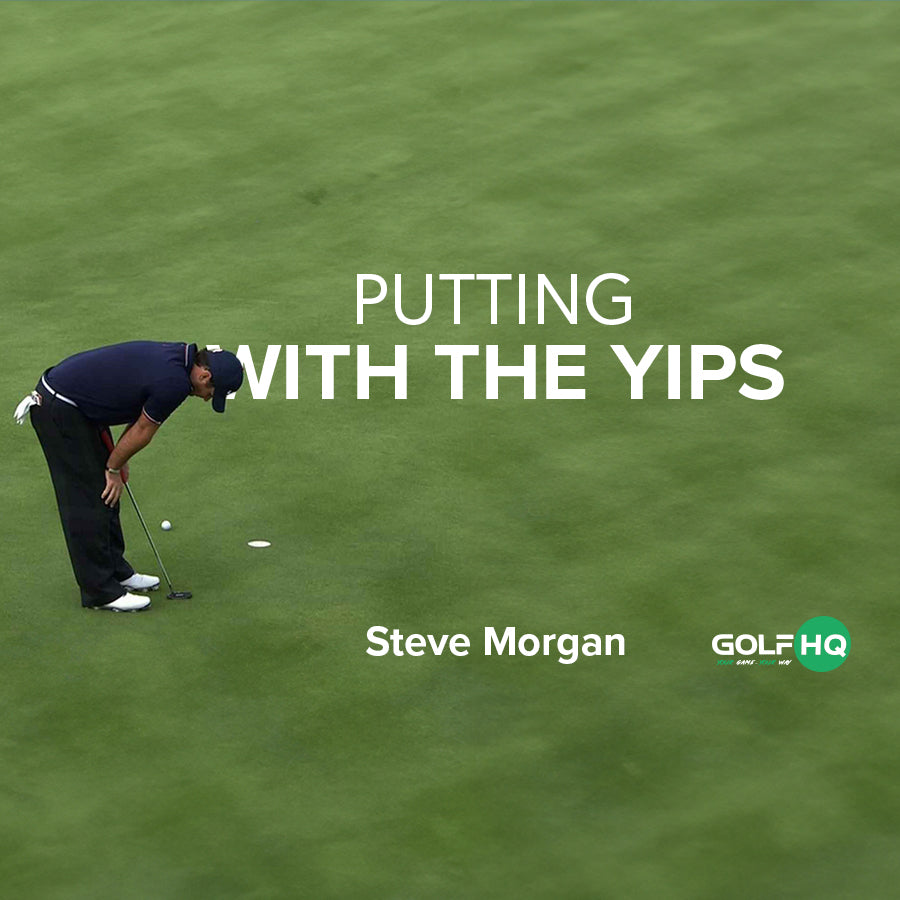Putting with the yips
So, when the bosses asked our Golf HQ team to write a blog on golf, putting instantly came to mind. Why? It’s probably been my biggest journey in golf so far and so crucial for me now as I play NZPGA trainee matches around Auckland every few weeks.
I started in the 1980’s with an old-style blade putter and as a junior I didn’t really have any options rather than hand me downs. I worked in the Proshop after school and holidays and found a putter I liked. I started experimenting with the swing and putter eventually bending the shaft to give me a higher hand position. It worked, but the shaft looked like a dog leg par 4 and I eventually changed back to a conventional shaft.
My return to golf 10 years ago saw me selecting a putter on looks and price. When I started regular coaching (with Blake) we reviewed my style of putting (conventional grip) and used a SEE More Putter with a centre shaft. I picked up the club and announced “it’s ugly” but it worked, and I loved it, for a while. See More style putters required you to block out the red dot on the head with the putter shaft thus giving a true straight back straight through stroke.
Playing the Wainui greens I struggled with longer putts on the sloping greens. One team tournament I remember my partner announcing that all day he had never SEEN MORE putts missed by me in one round. So, the SEE More was sold and eventually I found Scotty Cameron and his range. I settled on a mallet and thought I’d be right for a while. The stroke I was taught was the simple straight back and straight through that the face balance putters encouraged.
How do you know if you have the putting yips?
After playing well from tee to green I was relatively happy with my putter and stroke. Some gentle ribbing from my twilight partners over the course of the competition saw me doubting my stroke and missing a few short ones. Back to Blake where my stroke was fine...until he put me under pressure and then, yep, it was the YIPS.
On video analysis there was a muscle twitch just before impact. It was great to put a label on my missed short putts but not the label many golfers want. So, sticking with my Scotty putter style we decided on the Yip fix putting style “the claw. I used this with a Superstroke “claw” grip. The claw is a great grip as it does take your hands out of the swing and allows the lead left hand to stay straight at impact.
While this worked for several years, I needed to take my putting to a better level and get ideally under 30 putts per round. Playing different courses in trainee matches made putting a crucial and adapting to fast and slow greens ever few weeks was important to posting so reasonable scores. A few courses with large and slow greens where a challenge with this stroke as a long back swing stroke can inhibited with the claw grip. I needed something better.
After a few rounds on bigger greens Blake and I discussed going to the option of Arm Lock or wrist lock. Wow this is a big change and while this style has been getting more popular (Bryson, Foxy, Kucher) it was going to be hard to adapt. There are several options for arm lock including the Odyssey 2 ball, Evnroll Mid lock, but no Scotty Cameron’s. The next option was using the Superstroke wrists lock grip, and this could be put onto a Scotty. The lofts and lie on armlock or wrist lock are affected by the forward press needed for this style of stroke. I changed the lie of my Scotty and adjusted the loft from 3.5 deg to 5 Deg. This allowed me to forward press using the shape of the wrist lock grip to full effect.
I have always found its best to first just hand a player a putter and get them to adopt a natural style grip and stance and see what they come up with. This is often the best coaching method as putting can be unique. I grabbed my new putter and wrist lock grip and instantly went left hand low. I had experimented with this prior to the claw, and I did like it. Now it felt natural. I did use my right-hand fingers to help stabilise the wrist lock grip style and ended up pointing my left forefinger down the shaft. I had just gone with what my subconscious felt was best. Upon review using the Ping app and coaching, the ball was rolling nice.
How to recover from the putting yips?
It is so important though to get the basics right. A good fitting will check the 5 variables of a putter:
Length: Mine was 34 inches based on my wrist to floor height. With wrist lock I went to 35 inches to allow for my grip style. (Left hand low)
Lie angle: Mine was adjusted so I could have my hands closer to the body at setup and impact.
Loft angle: Most manufacturers are around 3 deg and this can be checked by a Pro and results can be analysed when using putter fitting apps. I changed mine to 5 deg to allow for the forward press.
Head weight/ Swing weight: Most of these are standard with a club. Mizuno putters do come with a range of head weights as part of their putters and are very useful to find the best fit. My head weight was standard 15 grms. (I had experiment with heavier weights in the toe to help balance a toe hang putter I was using for a while).
Putter head design attributes: This is variable between a face balance/ mid balance and toe hang putters. Face balance heads are often larger mallet styles and have a generous “sweat spot” making contact more achievable for most golfers.
Can you recover from the putting yips?
So, the outcome is still not proven, but after a few rounds where I have sunk a few good putts, I am feeling confident. (Tell yourself “I’m a great putter” ) especially over small putts under pressure the stroke feels solid. I am starting to believe I can hole more putts over 3 ft and keep the ball rolling along the straight line, after impact, to give the ball the best chance of taking the break at the right spot and dropping in the hole. Confidence in putting is key.
There is hope for anyone with the putting yips: Make a change, grip, stance, putter style- get that confidence back by getting a lesson from a Pro. Often the cause is easier detected by a coach through putting apps and video analysis. Try some styles that can help yips…claw, Left hand low, wrist and armlock or broomstick.
Alternatively look at some putting aids…the best I find for teaching is the IXIA True Pendulum Motion. This is great for getting the player to use their big muscles, arms and shoulders and prevents any wrist bend. Again, great for Yips, but helps all players who would be surprised how much wrists they use and how it can lead to inconsistency and missed putts.
Putting yips FAQs
As someone that has had to deal with the putting yips, I am often asked about them, usually after a round of golf. So many golfers have suffered with the yips and it is not just something that impacts putting. Does anyone remember when Tiger came back to golf after one of his many injuries and developed the chipping yips? If it can happen to him, it can happen to anyone but he went on to win the Masters a short while after so there is definitely hope for anyone who has suffered from the yips.
Here are some of the most commonly asked questions I get about the putting yips:
What are the putting yips?
I have given my explanation of how the putting yips impacted me, however, for a medical definition I found this description on Mayo Clinic:
The yips are involuntary wrist spasms that occur most commonly when golfers are trying to putt. However, the yips also can affect people who play other sports — such as cricket, darts and baseball.
It was once thought that the yips were always associated with performance anxiety. However, it now appears that some people have the yips due to a neurological condition affecting specific muscles. This condition is known as focal dystonia.
Changing the way you perform the affected task might help you find relief from the yips. For example, a right-handed golfer might try putting left-handed.
How do you fix the putting yips?
As a work in progressive, I have no definitive answer to this, however, what I would say is that you have to stick to a process. Pick a routine that is repeatable and focus on something other than the stroke itself.
There are lots of stories about how people have got over the yips including putting left-handed, trying different grips, different strokes and different ways of holding the putter, putting with your eyes closed or even putting with other clubs in your bag like a hybrid.
If you want a long-term solution, I would recommend going to see your local professional and getting an assessment of your stroke. Your pro will be able to give you some techniques to work on and a routine that can give you confidence when you step out on the greens and find yourself under pressure.
Hopefully this helps if you are struggling with the yips in any part of your game. If you are based in Auckland, come and see one of the team at Golf HQ, either at our Takapuna or Whangaparaoa store and we can help to put you on the right track to lower scores.
Putting With The Yips




1 comment
Paul
I find using the line for short putts and focusing on a specific dimple and looking down after the putt helps as well as sometimes practicing with eyes closed
After 2 long game lessons with the author i look forward to a short game/putting lesson – watching the PGA and seeing their low % success further from the hole is very interesting